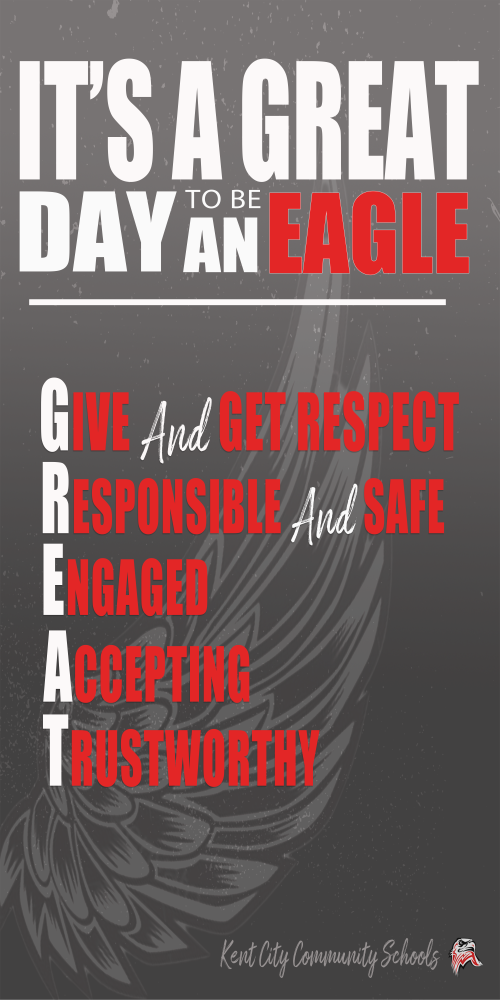Kent City — It’s the end of third hour at Kent City High School when the voice of Principal Jordan Stuhan fills the hallways as students move to their next class. Among the daily announcements is an urgent reminder to keep laptops in their assigned cases throughout the day to prevent breaking the valuable equipment.
A few moments later, as students settle into fourth period, seniors Irelyn Sullivan and Maddie Geers work independently on their devices — both of which are dutifully protected in compliance with Principal Stuhan’s announcement. Just a few weeks earlier they took part in a creative exercise designed to establish clear expectations for their behavior, including how they use technology, at school.
According to Maddie, learning about behavioral expectations could have been extremely boring. Instead, it used one of teens’ favorite things to help them learn: TikTok.
Dividing into small groups, students filmed short videos that demonstrate school values summarized by the acronym GREAT, which stands for “Give and get respect,” “Responsible and safe,” “Engaged,” “Accepting” and “Trustworthy.” To make the project even more fun, some groups opted to demonstrate what “GREAT” behavior is not. For example, a student video demonstrating “engaged” behavior related to technology might feature a student scrolling through social media while a teacher lectures the students.
“I would say it took a more fun perspective on it instead of just lecturing kids on what to do and what not to do,” like scrolling on your phone during class, Maddie said. “Making a little funny video about it made it easier to listen to.”
A Creative Approach to MTSS

In fact, it was students who recommended the video project in the spring of 2023 as they met with staff to give feedback on Kent City’s new approach to behavior called MTSS, short for Multi-Tiered Systems of Support.
“They told us they wouldn’t listen to it any other way,” said Susan Brummel, an educational consultant who is working with Kent City Community Schools to develop and implement the MTSS approach. “So we flipped it to have the kids teach (positive behaviors).”
MTSS is in its first year of implementation in Kent City and is designed to create a more positive environment in classrooms across the district. While student behavior has been an ongoing concern in the district, teachers and administrators wanted to try something different from the traditional approach to discipline that focuses on punishment for negative behavior, said Director of Student Services Eric VanTreese.
“How can we improve behavior by changing climate, culture and belongingness?” VanTreese said.
At Kent City Middle and High Schools, it means getting students involved in creating and sharing behavioral expectations — like with their fun videos — and creating a culture where positive behavior is consistently praised and rewarded. Assistant Principal Curt Gerbers says that if students are acknowledged for doing the right thing, the positive behavior will start to happen more among all students.
“We have some students who walk around doing the right thing all the time, and they never get any acknowledgement of that,” said Gerbers. “And we have some students who do the right thing most of the time, and then when they do the wrong thing they only get acknowledgement (for the negative behavior).”
Is Detention a Thing of the Past?
At Kent City’s secondary schools, traditional disciplinary practices like sending kids to detention aren’t going anywhere, Gerbers says — at least for now. Traditional discipline and MTSS run parallel to each other, and in time, should intersect and ultimately decrease the need for detentions, suspensions and other behavioral interventions, he maintains.
“Ultimately we’re trying to change behaviors and get kids to learn,” Gerbers said. “We don’t want kids sitting in detention, we want them in the classroom.”
Still, students sometimes act out, even if they know what the rules are.
“We’ve got plenty of students here who just make a bad decision in the moment. They know what’s appropriate and a reminder of that can be helpful,” Gerbers said.
Calls to parents and caregivers may still happen because administrators want them to be involved in what’s going on in their student’s life at school. And when students put themselves or others in danger, school officials will fully comply with the requirements of the law to provide appropriate consequences.
‘We don’t want kids sitting in detention, we want them in the classroom.’
— Curt Gerbers, Kent City High School assistant principal
When Negative Behaviors Persist
Part of creating a system that supports students to achieve behavioral and academic goals is providing additional support from social workers, counselors and school administrators, to help address concerns that might be leading to disciplinary issues.
While having students create fun educational videos is considered a Tier 1 MTSS strategy, some students may need to receive Tier 2 support if teachers see a pattern of negative behaviors in class. Teachers log concerns in an MTSS data system, where administrators can look at trends to identify students who may need more attention. This could entail a check-in, check-out practice with a school administrator, or the student may be referred to a mental health counselor who can help the student dig into what’s causing them to act out.
Rewarding Good Behavior
While Kent City’s secondary schools aren’t currently giving tangible rewards for positive behavior, school staff are working on a point system that they may pilot later in the year. It would allow students to earn free coffee or items at a school store when they’re caught being “GREAT.”
Even without rewards, the positive approach to teaching and reinforcing behavioral standards is already making an impact, says Brummel.
“I stopped into one of the middle-school teachers and said, ‘So how is the start of the school year going?’” Brummel said. “And her response was: ‘Best year ever!’”
Read more from Kent City:
• Filling students’ buckets with praise
• Kent City superintendent talks safety, new initiatives









